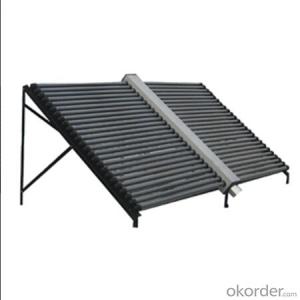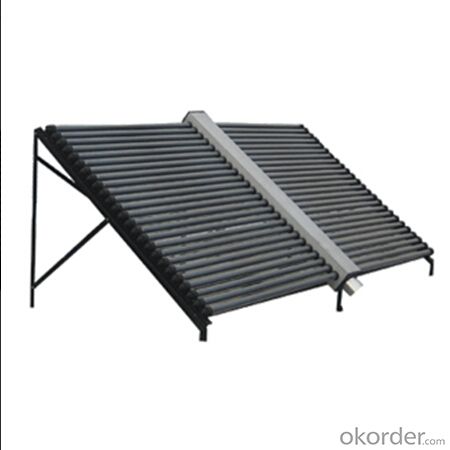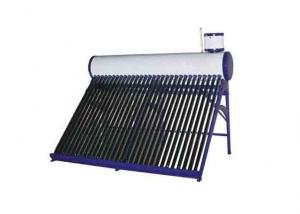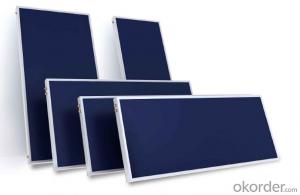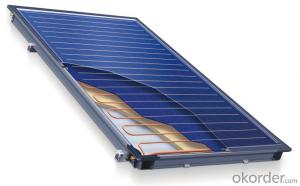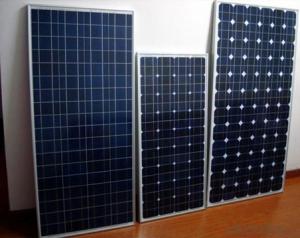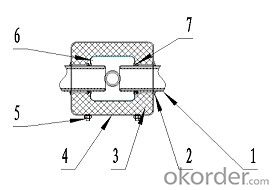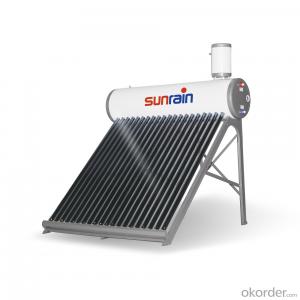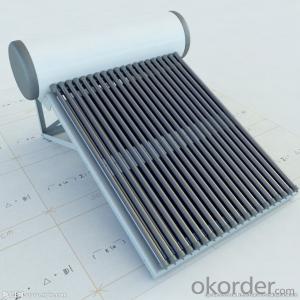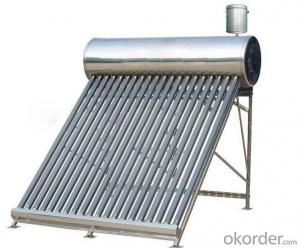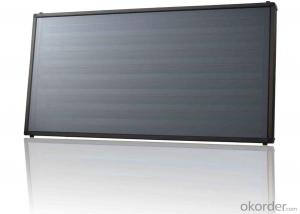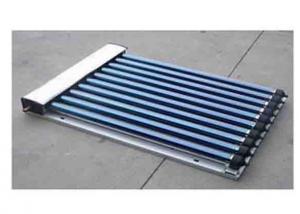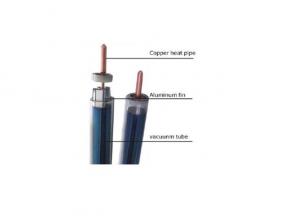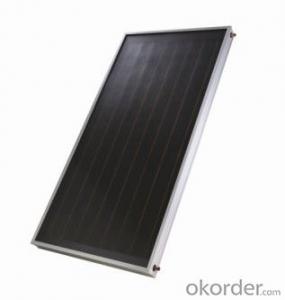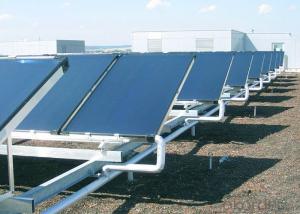Low Temperature Solar Collectors - No-Pressurized Solar Collector Model SC-V
- Loading Port:
- Shanghai
- Payment Terms:
- TT or LC
- Min Order Qty:
- 100 set
- Supply Capability:
- 500 set/month
OKorder Service Pledge
OKorder Financial Service
You Might Also Like
1. Structure of Solar Project No-pressurized Solar Collector Model SC-V
This kind of solar collector is designed for commercial buildings,Suitable for schools, dormitories, hotels, bath centers and other public constructions as well.
It is composed by the following parts:

1.vacuum tube 2.dustproof rubber 3.polyurethane insulation 4.casing 5.fixed bolt 6.inner tank 7. nozzle seal ring |
|
2. Main Features of Solar Project No-pressurized Solar Collector Model SC-V
Food grade SUS304 inner tank, corrosion resistant for long service life.
Unpressurized, suitable for natural circulation system,in large collector area,easy to assemble and install.
Polyurethane insulation, High pressure foaming process, small heat conductivity coefficient, not easy to loss heat.
3. Solar Project No-pressurized Solar Collector Model SC-V Images

4. Solar Project No-pressurized Solar Collector Model SC-V Specification
Model | SC-V-50-II | SC-V-60-II |
Tube Qty(pcs) | 50 | 60 |
Tube Pitch(MM) | 75 | 75 |
Tube Diameter/ Length(MM) | φ58/1800 | φ58/1800 |
Vacuum Tube Material | high borosilicate glass 3.3 | high borosilicate glass 3.3 |
Thickness of Inner Tube/OuterTube(MM) | 1.6/1.8 | 1.6/1.8 |
Inner tank Material / Thickness(MM) | SUS304/0.41 | SUS304/0.41 |
Joint Specification | 1″ | 1″ |
Insulation Material/ Thickness(MM)) | Polyurethane/40 | Polyurethane/40 |
Rated Pressure(MPa) | 0.003 | 0.003 |
Working Temperature ℃ | <100 | <100 |
Capacity(L) | 145 | 175 |
Collecting Area(㎡) | 4.8 | 5.8 |
Gross Area(㎡) | 7.72 | 8.24 |
Referral Traffic(L/min) | 5.76 | 6.96 |
Intercept Efficiency η0 | 0.62 | 0.62 |
Heat Loss Coefficient a | 3.0 | 3.0 |
Collector Net Weight(kg) | 12.5 | 129.5 |
Horizontal installation size | ||
Angle | 15° | 15° |
a (㎜) | 2060 | 2435 |
b (㎜) | 1974 | 2349 |
c (㎜) | 1860 | 2335 |
d (㎜) | 2023 | 2360 |
e (㎜) | 2200 | 2550 |
f (㎜) | 770 | 860 |
G (㎜) | 3715 | 3715 |
H (㎜) | 3560 | 3560 |
H/2 (㎜) | 1780 | 1780 |
5. FAQ
(1). Are the solar collectors noticeable on the roof?
If only the collector is mounted on the roof it should blend into the roof design quite well. Our solar collectors are very thin and can be flush mounted on a roof. From a distance they look somewhat like a skylight. You may have to check with your local council regarding building restrictions when installing your solar collector.
(2). Can the solar collectors be mounted on a flat surface?
Yes they may be mounted on a flat roof or on the ground by using a stainless steel Flat Roof Frame. The collector should be installed at a minimum of 20o angle to ensure optimal heat pipe operation.
(3). How do I protect my solar system during subzero temperatures?
If you have a system that is operating in areas with subzero temperatures, freeze protection must be implemented. The easiest means of preventing freezing is to use a controller with a low temperatures setting, so when the manifold temperature drops below a certain pre-set temperature (5oC/40oF), the pump will circulate, warming the collector with water from the bottom of the storage tank. The pump will not run continually, just periodically, the frequency of which will depend on the outside temperature. In extremely cold areas, a closed loop using a glycol/water mix may be appropriate.
- Q: Can solar collectors be used for heating poultry houses?
- Yes, solar collectors can be used for heating poultry houses. Solar collectors, such as solar water heaters or solar air heaters, can harness the heat from the sun and transfer it to the poultry house, providing an energy-efficient and sustainable heating solution. This can help maintain comfortable temperatures for the poultry, enhance their well-being, and reduce the reliance on traditional heating methods, thereby saving costs and reducing environmental impact.
- Q: Can solar collectors be used for heating train stations and public transportation terminals?
- Yes, solar collectors can indeed be used for heating train stations and public transportation terminals. By harnessing solar energy, these collectors can provide a sustainable and renewable source of heat to these facilities, reducing their dependence on traditional energy sources and lowering their carbon footprint. Additionally, the use of solar collectors can result in cost savings and contribute to a more environmentally friendly transportation system.
- Q: Can solar collectors be used for generating electricity on home appliances?
- Yes, solar collectors can be used for generating electricity on home appliances. Solar collectors, also known as solar panels, convert sunlight into electricity through photovoltaic cells. This electricity can be used to power various home appliances, reducing reliance on traditional energy sources and promoting sustainability.
- Q: Can solar collectors be used in mining operations?
- Yes, solar collectors can be used in mining operations. They can be employed to generate renewable energy for various mining activities, such as powering equipment and machinery, providing electricity to remote mining sites, or heating water for mineral processing. Solar collectors offer a sustainable and cost-effective alternative to traditional fossil fuel-based energy sources, reducing both operational costs and environmental impact in mining operations.
- Q: How do solar collectors perform in coastal areas?
- Solar collectors perform well in coastal areas due to the abundance of sunshine and the relatively cooler climate. The proximity to the ocean helps regulate temperature and reduce heat stress on the collectors, while the strong coastal winds can help keep them clean from dust and debris. Additionally, the availability of open space in coastal regions allows for efficient placement of solar panels, maximizing their exposure to sunlight and optimizing their performance.
- Q: Are there any health risks associated with solar collectors?
- Yes, there are no direct health risks associated with solar collectors. However, there may be potential indirect hazards during the manufacturing and installation processes, such as exposure to chemicals or falls from heights. Proper safety protocols must be followed to minimize these risks.
- Q: Can solar collectors be used in commercial areas?
- Solar collectors have the potential to be utilized in commercial areas. As a matter of fact, an increasing number of businesses are choosing to employ solar collectors to tap into the sun's power for their energy requirements. Solar collectors, including solar panels and solar thermal systems, can be positioned on the roofs, parking lots, or any accessible open space within commercial areas. These collectors convert sunlight into electricity or heat, which can then be employed for various purposes such as powering lighting systems, heating water, or even operating entire commercial operations. The utilization of solar collectors in commercial areas not only aids in reducing electricity expenses and lessening dependence on fossil fuels, but it also presents businesses with an opportunity to contribute to sustainability endeavors and enhance their eco-friendly image. Moreover, government incentives and tax credits for renewable energy installations often make investing in solar collectors financially feasible for businesses. Consequently, solar collectors represent a viable and advantageous choice for commercial areas seeking to embrace clean and renewable energy solutions.
- Q: How do solar collectors perform in areas with frequent power outages?
- Solar collectors can be a reliable source of electricity in areas with frequent power outages. Since solar collectors generate electricity from sunlight, they are not dependent on the grid for power supply. This means that even during power outages, solar collectors can continue generating electricity, providing a consistent source of power. However, it is important to note that the effectiveness of solar collectors during power outages may depend on factors such as the capacity of the system, the availability of sunlight, and the presence of backup storage solutions like batteries.
- Q: Can solar collectors be used for heating hospitals?
- Yes, solar collectors can be used for heating hospitals. Solar thermal systems can be installed to generate hot water or provide space heating in hospitals, reducing their reliance on traditional heating methods and lowering energy costs. Solar collectors capture sunlight and convert it into thermal energy, which can then be used for various heating purposes within the hospital.
- Q: Can solar collectors be used for heating police stations?
- Yes, solar collectors can be used for heating police stations. Solar thermal systems can be installed to harness the sun's energy and convert it into heat, which can then be used to provide heating for buildings, including police stations. This can help reduce dependence on traditional heating systems and promote environmental sustainability.
Send your message to us
Low Temperature Solar Collectors - No-Pressurized Solar Collector Model SC-V
- Loading Port:
- Shanghai
- Payment Terms:
- TT or LC
- Min Order Qty:
- 100 set
- Supply Capability:
- 500 set/month
OKorder Service Pledge
OKorder Financial Service
Similar products
Hot products
Hot Searches
Related keywords
